Tyne and Wear Metro rolling stock
The Tyne and Wear Metrocars are a fleet of light rail vehicles manufactured by Metro-Cammell for the Tyne and Wear Metro in North East England between 1975 and 1981. For operation on Network Rail controlled tracks between Pelaw Junction and Sunderland, they are designated on TOPS as the Class 599 (units 4001, 4002, 4040 and 4083) and 994s (all other units). 86 units were refurbished between 2010 and 2015 by Wabtec Rail at Doncaster Works and are scheduled to be replaced by Stadler Rail built rolling stock from 2022.
| Tyne and Wear Metrocar | |
|---|---|
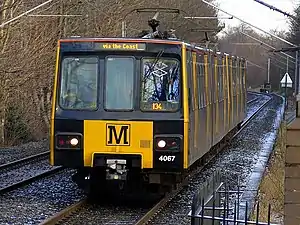 A Metrocar, in the current black and yellow corporate livery at Meadow Well in January 2018 | |
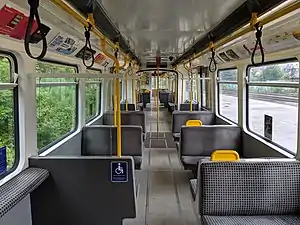 Refurbished interior of a Metrocar | |
| In service | 1980–present |
| Manufacturer | Metro-Cammell |
| Built at | Washwood Heath |
| Constructed |
|
| Entered service | 1980 |
| Refurbished |
|
| Number built | 90 |
| Number in service | 89 |
| Formation | 2 carriages per unit (semi-permanently coupled with a Jacobs Bogie) |
| Fleet numbers | Tyne and Wear Metro: 4001–4090 TOPS: 599: 001, 002, 040, 083 994: 003-039, 041-082, 084-090 |
| Capacity | 64 seated 188 standing |
| Operator(s) | Tyne and Wear Metro |
| Depot(s) | Howdon South Gosforth |
| Specifications | |
| Car body construction | Aluminium and steel |
| Car length | 4.3 SLU 27.8 m (91 ft) |
| Width | 2.65 m |
| Height | 3.45 m |
| Doors | 4 sets of air-operated double doors on each side |
| Maximum speed | 50 mph (80 km/h) |
| Weight | 40 metric tonnes |
| Power output | 700 HP per unit |
| Electric system(s) | Overhead line (1,500 V DC) |
| Current collection method | Pantograph (Brecknell Willis high reach) |
| Multiple working | Units operate in pairs. Unused passenger capability for 3 units. 3 and 4 unit formations are for empty stock movements only. |
| Track gauge | 4 ft 8 1⁄2 in (1,435 mm) standard gauge |
Design
The design of the Metrocars was partly derived from that of the German Stadtbahnwagen B. However, they were built by Metro-Cammell in Birmingham, and were not fitted with the lights and indicators that would have allowed them to run on streets.[1]
Each Metrocar consists of two semi-permanently connected coaches mounted on three bogies, with the middle bogie being a Jacobs Bogie. The outermost bogies are powered and the centre Jacobs Bogie, located in the articulated section between both halves is unpowered. The trains make use of rheostatic braking between 80 and 30 km/h (50 and 20 mph), with air-operated disc brakes for use during the final stages of deceleration below 30 km/h (20 mph). All bogies are also equipped with a pair of emergency magnetic track brakes, which can be used to bring a train to a complete stand in as little as 150 m (160 yd) from the maximum service speed of 80 km/h (50 mph). Metrocars have three acceleration steps, and four braking steps, and an additional emergency brake step which drops the emergency magnetic track brakes.
Many features of the Metrocar are operated by compressed air which is stored in a reservoir under the driving cab at the front of the train. Features operated by air include: air-operated disk brakes, horn, windscreen wipers and passenger doors, as well as being used to raise the pantograph. As the section between Pelaw and Sunderland on which they operate is part of the Network Rail system, the units are allocated TOPS numbers; the four not overhauled in the early 2010s are classified as class 599s (001, 002, 040 and 083) with the remainder classified as 994s.[2][3]
- Specification
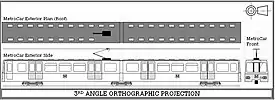 Metrocar external details (third-angle projection)
Metrocar external details (third-angle projection)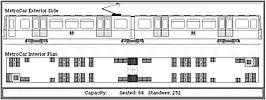 Metrocar internal details (first-angle projection)
Metrocar internal details (first-angle projection)
Prototypes and test track
Prior to opening, two prototypes, 4001 and 4002, underwent several years of testing from June 1975 on a 1.5-mile (2.4 km) test track in Backworth.[4][5] The track was built on the route of an old mineral wagonway formerly part of the North Tyneside Steam Railway. It had a two-lane car shed and a mock station platform, along with a short tunnel section which consisted of concrete tunnel segments laid at ground level;[6] the tunnel was later demolished to allow testing of prototype cars for the Hong Kong MTR, also built by Metro-Cammell, these cars having a very large profile. The test track was closed in 1980, and it is now home to the Stephenson Railway Museum.[6]
The prototype cars are very similar to the production fleet, with the exception of having Kiekert passenger doors, which were refitted to match the specification of the production fleet before entering passenger service. The prototype cars were also fitted with two different types of block coupling equipment (one at each end), allowing the two designs to be thoroughly tested. The prototypes featured small cabs and central end doors similar to London Underground stock, to allow evacuation of trains in a tunnel. In the event, the Metro tunnels were constructed with continuous sidewalks, making the end doors unnecessary. Prior to their entry into service, the two prototypes were refitted to reflect the specification of the production fleet. The small cabs remained in the series vehicles with a passenger seat beside offering a forward view.
Including the two prototype cars, a total of 90 Metrocars were constructed (the original specification for the system stated 120 trains, but this number was cut back due to funding problems). All but one of the 90 units are in passenger service today, the exception being 4022, which was involved in a derailment at Gosforth depot in March 2017 and sustained significant damage.[7] The unit was sent to Bristol Barton Hill TMD for assessment by Wabtec Rail,[8] however it was deemed that the unit was damaged beyond economical repair,[9] so it was stabled there for use for parts.[10] In late October 2019, 4022 moved to the Nemesis Rail facility at Burton upon Trent, for disassembly and scrappage.
Livery
The Metro fleet was initially painted in a two-tone livery of cadmium yellow and white that matched the Metro station design and the livery of the Tyne and Wear bus fleet until 1986. In the mid-1990s, a new colour scheme was introduced - solid red, green or blue with a yellow wedge at each end and yellow triangles on the doors. This scheme was modified slightly in 2005, in part to comply with safety regulations - the doors were changed to solid yellow to comply with the Disability Discrimination Act 1995. In addition to the standard colour scheme, a large number of special liveries existed. These were often advertisements for local businesses such as Metrocar 4042 advertising the Evening Chronicle. To celebrate the Golden Jubilee of Elizabeth II in 2002, unit 4032 was temporarily decorated in a special gold livery. It was then returned to the red and yellow livery, which it carried until refurbishment.
Between 2012 and 2015, 86 Metrocars were refurbished and repainted in a black and yellow livery.[11] The refurbishment reduced the number of liveries in use. Metrocars 4033 and 4082 carried a promotional livery for Emirates, although they have since been repainted to match the other units.[12] Unrefurbished Metrocar 4083 continues to carry an Emirates livery. Until 2017, prototype unit 4001 carried its original cadmium-and-white livery whilst 4002 carried an advertisement for the Tyne and Wear Metro website. Both were repainted in 2017 into the same black and yellow livery carried by the refurbished Metrocars, but in September 2019, Metrocar 4001 underwent further repainting into a 40 Years livery with all four previous liveries amalgamated into one. In August 2019, Metrocar 4040 was repainted to the cooperate black and yellow, and 4083 followed shortly after in May 2020. As a consequence of this, the only liveries that currently exist are the standard black and yellow, and the "40 Years" celebration livery on 4001.
- Metrocar livery and branding
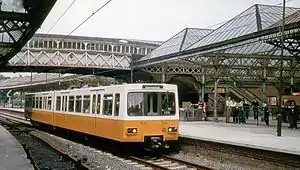 1980–1990s
1980–1990s 1990s–2010s
1990s–2010s.jpg.webp) 2010s–present
2010s–present
Electrics
The network is electrified with a 1,500 V overhead line system using DC current. This voltage was previously used on the Woodhead line but is now unique in the United Kingdom. Each Metrocar has its own Brecknell Willis high reach pantograph for collecting power from the overhead line. Metro has a maximum speed of 80 km/h (50 mph), which it attains on rural stretches of line however the Metrocars are technically capable of 90 km/h. The vehicles have a minimum curve radius of 50 m (55 yd), although there are no curves this tight except for the non-passenger chord between Manors and West Jesmond.
Formation
During the early years of Metro, units were operated in single and double sets. As single units became overcrowded, Nexus resumed using two units as standard.[13] Single units again became common during construction of the Sunderland extension when some units were taken for testing of the new track. During original construction, the Metro system was designed to use three unit sets, and some platforms were constructed to accommodate this; however, due to a lack of funding, this was not possible. As a result, the units run in sets of two.
Announcements
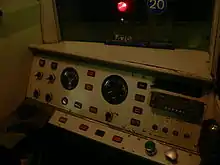
The "stand clear of the doors please" announcement, which sounded before the doors started to close, was introduced in 1991. In order to increase the clarity of the announcement (especially for individuals not fluent in English) the phrase was replaced with "doors closing" in 2004.
In 2011, the "doors closing" recording was replaced in post-refurbishment Metrocars with a simple beeping sound, similar to that of the London Underground. The train emits a solid 3-second beep when the doors are released, and a rapid 3-second beeping immediately before the doors are closed, in line with the 2010 UK Rail Vehicle Accessibility Regulations (RVAR).
When the automated next station announcements were introduced they featured a female announcer, however during late 2014 this was replaced with a male announcer.
Refurbishment
All 90 underwent a half life refurbishment between 1996 and 2000.[14] In June 2010, Wabtec Rail was awarded a contract to perform a three-quarter life refurbishment to all 90 units at Doncaster Works which included making them compliant with the Disability Discrimination Act 1995.[15][16] The first was completed in February 2012 with the last in July 2015.[17][18] Cost overruns resulted in only 86 being completed, with 4001, 4002, 4040 and 4083 remaining in service in unrefurbished condition.[19] Because they do not comply with the Disability Discrimination Act 1995, they are restricted to peak hour services.[14]
The refurbishment saw the trains undergo corrosion correction work, to repair damage as a result of the trains' steel and aluminium construction, new seating, flooring and interior finish, in addition to improved saloon and emergency lighting. A new larger wheelchair space has also been created at the end of each car, featuring a "call for assistance" device. Other minor modifications include improved door seals, more concise interior signage and removal of the green boarding lamps to facilitate new audio warning equipment for door operation. Some Metrocars also featured air conditioning boxes at their A end to control the conditions within the drivers cab, these were later removed from the units due to OHLE clearance issues if trains were to be placed on wheelskates. Passenger counters were integrated above doors to help Nexus analyse trends in passenger levels. These features were removed from the specification midway through the refurbishment however. In early 2020, 4001,4002,4040 and 4083 had its luggage bay in the middle of the carriage converted to a disabled bay making it in a different area than the refurbished units but now complying with the Disability Discrimination Act 1995. This units are still most commonly sighted on peak services but can also be seen across the network again usually as back up trains but give the Metro more flexibility with the common breakdowns of its ageing 40 year old fleet of trains.
Replacement
In January 2020. Stadler Rail was awarded a contract to build 42 (later increased to 46) five-carriage light rail sets to replace the Metrocars, with deliveries to commence in late 2021.[20][21][22][23]
References
- Metro trains celebrate 40 years of service Nexus 8 June 2015
- Sunderland Direct - Unique Signalling Rail issue 435 15 May 2002 pages 32-35
- The Rail Vehicle Accessibility (Non-Interoperable Rail System) (Tyne and Wear Metro Specialist Metrocar) Exemption Order 2019 Department for Transport
- Backworth will be Tyne and Wear proving ground Railway Gazette International March 1976 page 82
- "How Metro was built". Nexus. Retrieved 4 September 2019.
- Young, Alan (22 May 2017). "Tyne and Wear Metro Test Track". Disused Stations. Retrieved 4 September 2019.
- "Tyne and Wear Metro: Fleet Refurbishment List". RailUK Forums. Retrieved 17 September 2018.
- "Tyne and Wear Metro: Fleet Refurbishment List". RailUK Forums. Retrieved 17 September 2018.
- Éponine), this hussie (your brat (12 October 2019). "Both? 4022 has been there since July 2017. Went for an appraisal for repair but deemed uneconomic. Future unknown". @BeingCharley. Retrieved 12 October 2019.
- Éponine), this hussie (your brat (12 October 2019). "It isn't being repaired. It has been formally written off, but remains languishing with an uncertain future. The belief is it's there just in case there's more significant damage to any of the remaining units before their replacement". @BeingCharley. Retrieved 12 October 2019.
- Tyne and Wear Metro goes grey Rail issue 681 19 October 2011 page 15
- "Tyne and Wear Metro: Fleet Refurbishment List". RailUK Forums. Retrieved 17 September 2018.
- "May 2002 Sunderland Extension". Railway Technology. Retrieved 20 February 2007.
- Rail Vehicle Accessibility: Exemption application Department for Transport 2018
- Wabtec to refurbish Tyne and Wear Metro trains International Railway Journal 10 June 2010
- Metrocar takes to road as £20m refurbishment begins Nexus 22 June 2010
- New Tyne and Wear Metrocar takes to the tracks BBC News 16 February 2012
- Refurbished Metrocar re-enters traffc Rail issue 691 7 March 2012 page 19
- Metro train fleet refurbishment is completed Nexus 30 July 2015
- Tyne and Wear Metro: Swiss firm Stadler to build new fleet BBC News 28 January 2020
- Stadler wins Tyne and Wear Metro fleet contract International Railway Journal 28 January 2020
- Stadler to build Tyne and Wear metro fleet Metro Report International 28 January 2020
- Rail in the 2020 budget Railway Gazette International 12 March 2020
External links
| Wikimedia Commons has media related to Tyne and Wear Metro trains. |
